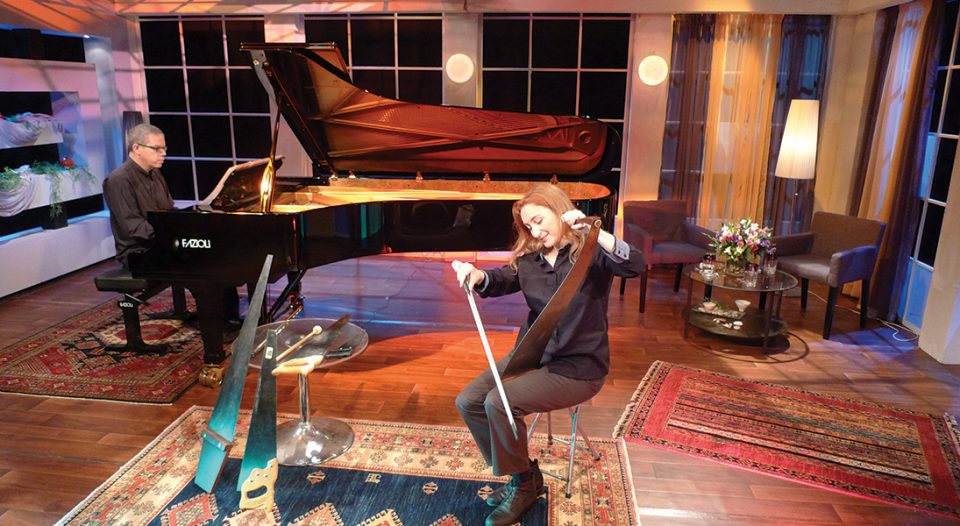“I relish the experience of playing for Sunday services,” said Natalia Paruz. That isn’t unusual coming from a Lutheran professional musician, but Paruz plays an unusual instrument—the musical saw.
The Saw Lady, as she is known (also her trademark), stays busy. At her congregation, Trinity Lutheran of Astoria and Long Island City in Queens, N.Y., parishioners regularly enjoy her musicianship during worship. Paruz routinely plays for concert audiences and subway passersby. Her work also graces film soundtracks—notably the 2011 science-fiction romance Another Earth—and the public radio show A Prairie Home Companion.
Her “singing saw” has a soaring high register—“closest to the range of a flute,” she said—and a distinctive timbre, similar to a wordless soprano vocal or the theremin, an early electronic instrument (think the Beach Boys’ “Good Vibrations”). Paruz uses it to create evocative worship experiences. “Most churches ask me to play from the altar because they say the congregation would enjoy seeing me play,” she said, “but my favorite church performances are when I sit next to the organist, allowing the sounds to be ‘seen and unseen,’ like a heavenly host.”
These experiences reach beyond church. Once, when she was playing at Union Square, a man waiting for a train heard her from afar. He abandoned the platform to look for the mysterious sound, thinking he had gone to heaven and was hearing angels.
A peculiar and practical instrument
The saw began its artistic life as a folk instrument. First struck with a mallet, eventually bowed like a cello (Paruz bows a specially made, toothless model), it found regular use in early 20th-century vaudeville and in rural areas where saws outnumbered instruments. It was likely first used in a liturgical setting in the early 19th century, when missionaries who couldn’t afford to travel with musical instruments relied on the saw as an accessible tool for both construction and musical purposes.
Later in the 20th century, composers employed the instrument’s ability to sound eerie. George Crumb’s 1970 masterpiece “Ancient Voices of Children” accounts for most of the saw’s concert hall appearances.
Generally, though, the saw remains obscure. “Most composers, as knowledgeable and illustrious as they are with other instruments, simply have not enough acquaintance with the musical saw,” Paruz said. She often commissions pieces and has worked closely with composers Eyal Bat and Scott Munson, who wrote the song Paruz performed for Another Earth.
Paruz credits her vocation to providence. She was a professional dancer who trained with the Martha Graham Dance Co. But one day as she was walking in Manhattan, a taxi hit her, damaging her spine and ending her career. Devastated, she traveled to Europe with her parents. There she first witnessed a musical sawist. Captivated by the way the man used his upper body—“It was like a dance,” she said—Paruz realized she had been shown a new calling.
“Faith can dispel fear and prove our perceptions wrong. … It comforts us when there is no human comfort to be found, and it propels us forward.”
“I have learned that what scares us is not reality, but reality as we perceive it,” she said. “Faith can dispel fear and prove our perceptions wrong. … It comforts us when there is no human comfort to be found, and it propels us forward.”
The European sawist refused to give Paruz lessons, telling her she needed to figure the instrument out on her own. “During the 20th century, most sawists were self-taught on account of the scarcity of sawists—they were located too far from one another to be able to take lessons,” she said. “Nowadays, most sawists are self-taught on account of YouTube videos teaching how to play.”
Paruz gives some lessons but encourages aspiring sawists to experiment first. Doing so “enabled me to develop my own playing technique, and therefore my own sound,” she said.
Still, music fosters community. “So many people have stopped to tell me how hearing me play reminds them of their childhood preacher at church or missionary at Bible camp who played the saw,” she said.
Paruz has pored over newspaper archives, finding articles and obituaries about clergy who played the saw, both in worship and at social gatherings. Each account speaks to a unique moment of fellowship formed around this most peculiar, but practical, of instruments.
Learn more and listen to musical clips at sawlady.com.





